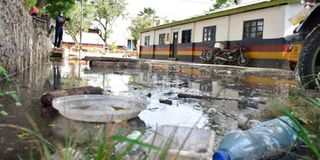Match sewerage with expansion and population

This picture taken on January 28, 2022 shows Mombasa's Central Police Station traffic department compound flooded with raw sewage. Officers were forced to relocate their operations to the Inspection Unit offices.
What you need to know:
- Most counties experience burst sewers or overflown septic tanks, which is the most common method of disposal.
- Releasing raw sewage directly into water bodies, as almost always happens, is degradation of the environment.
As towns develop rapidly and rural-urban migration increases with many Kenyans in search of greener pastures, infrastructural development like sewer connections and fresh water supply is a challenge.
Apart from major cities like Nairobi, Mombasa, Kisumu and the recently elevated Nakuru, where proper sewage treatment exists but faces challenges with sewer connections, towns need adequate modern engineered methods of night soil and waste water disposal and treatment.
Few towns have sewage treatment plants. It could be in form of oxidation ponds, where both aerobic and anaerobic methods are used, and bacteria break down sewage, assisted heavily by sunlight with the final effluent ending up in a water body with tests, including the bacteria oxygen demand (BOD), done.
Most counties experience burst sewers or overflown septic tanks, which is the most common method of disposal in most residential homes, and much of this effluent ends up in the rivers or roadside drains.
Expensive venture
Sewage treatment, like waste management, is an expensive venture and counties have to set aside substantial amounts of money to provide proper infrastructure, which will involve sewer trunk lines from homes and offices to the treatment plant.
There is also the issue of where the final effluent will be treated. Releasing raw sewage directly into water bodies, as almost always happens, is degradation of the environment.
Use of pit latrines in towns is unhealthy and obsolete. Residential houses, factories and offices should be compelled to connect to the sewer, where they exist, and in this way counties will earn an income in form of sewer connection fee, which will be included in the water bills.
The old sewer lines that the counties inherited from the defunct municipalities and town councils can be improved and expanded. Counties can also share a final treatment plant if they are in close proximity to one another and where lack of land in one county is not a problem.
We cannot talk of green and clean cities when sewage flows freely on the roads and waste is strewn all over the streets.
Mr Kigo is an environment officer with Nairobi County government. [email protected]





